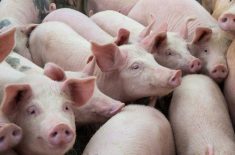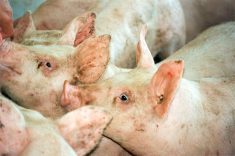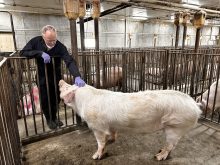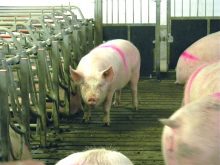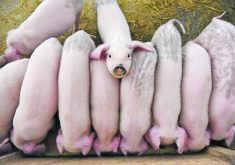PED monitoring | Cases of the virus slowing but there is still work to do
DES MOINES, Iowa — Hog farmers have a brief respite from the worst of porcine epidemic diarrhea virus and researchers are scrambling to make it more than just a pause.
“It seems to be declining,” said Tom Burkgren, executive director of the American Association of Swine Veterinarians, about summer temperatures apparently causing fewer weekly new outbreaks of PED.
“Don’t let your guard down. It’s not time to let your biosecurity down. It’s time to leverage the heat.”
Burkgren said PED outbreaks are likely to surge again in the fall and researchers hope to make hog farms better able to handle the virulent disease — which has now killed about seven million piglets — when it returns in full force.
Read Also

The Western Producer Livestock Report – November 6, 2025
Western Producer Livestock Report for November 6, 2025. See U.S. & Canadian hog prices, Canadian bison & lamb market data and sales insights.
PED, like many viruses, survives well in cold weather but is unstable in warm temperatures. Over the fall, winter and spring PED infections rose from about 100 in late May 2013 to 4,700 by the time of this year’s World Pork Expo in the first week of June.
The disease has spread across the American hog herd and into both eastern and western Canadian herds. It is actually two strains of PED, which most researchers believe came into the U.S. already separately developed, while delta coronavirus is also circulating the in U.S. herd. All three diseases appeared after March 2013.
National Pork Board vice-president for science and technology, Paul Sundberg, said researchers need to crack some remaining mysteries of PED in order to give farmers the tools to control its spread.
That includes understanding how to create and sustain immunity in sows that have been exposed to the disease.
A number of veterinary experts said solving the mystery of sow immunity is key to stopping the resurgence of the disease in barns “cleaned” of an outbreak, because outbreaks have been taking longer to end since January.
Burkgren said the virus acts mysteriously, badly affecting some barns that practice high biosecurity but being less damaging to some that have lower biosecurity.
And it will hit some sows hard but ones right behind them little. And right when it seems to have disappeared from a barn it can reappear.
“We don’t know a lot about sow immunity,” said Burkgren.
“It is a surprising virus and it just pops up.”
Sundberg said researchers hope to use the masses of information they have already compiled to unravel the remaining mysteries.
“We’ve had a lot of success,” said Sundberg.
“We’ve learned an awful lot.”
The search for the disease origin continues, with multiple veterinarians at the World Pork Expo saying solving that mystery is key to ensuring that pathway of disease is closed. However, U.S. Department of Agriculture animal health inspection head John Clifford described that as searching for a “needle in a haystack.”





